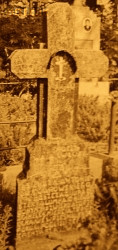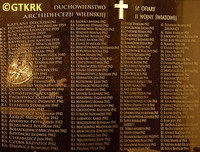Roman Catholic
St Sigismund parish
05-507 Słomczyn
85 Wiślana Str.
Konstancin deanery
Warsaw archdiocese, Poland
full list:
displayClick to display full list

searchClick to search full list by categories
wyświetlKliknij by wyświetlić pełną listę po polsku

szukajKliknij by przeszukać listę wg kategorii po polsku

Martyrology of the clergy — Poland
XX century (1914 – 1989)
personal data

surname
ZUZIAK
surname
versions/aliases
MARCZYK
forename(s)
Stanislav (pl. Stanisław)
function
religious seminarian
creed
Latin (Roman Catholic) Church RCmore on
en.wikipedia.org
[access: 2014.09.21]
congregation
Society of Christ Fathers for Poles Living Abroad SChrmore on
en.wikipedia.org
[access: 2013.05.19]
(i.e. Christ Fathers)
date and place
of death
19.09.1939

between Lipnishki and Stiganetoday: Ivye dist., Grodno reg., Belarus
more on
be.wikipedia.org
[access: 2023.01.18]
alt. dates and places
of death
18.09.1939, 01.10.1939
Lipnishkitoday: Lipnishki ssov., Ivye dist., Grodno reg., Belarus
more on
be.wikipedia.org
[access: 2023.01.18]
Stiganetoday: Lipnishki ssov., Ivye dist., Grodno reg., Belarus
more on
be.wikipedia.org
[access: 2022.01.06]
details of death
On 01.09.1939 the day of German invasion of Poland (Russians invaded Poland 17 days later) and start of the II World was in the eastern Poland at pastoral training.
Reached Lida — Possibly using MARCZYK name.
Prob. there met Fr Anthony Twarowski, Juraciszki parish priest.
Decided to join him in a return trip to his Juraciszki parish, c. 80 km east from Lida.
On the way apprehended in Kniazikowce Wielkie village, c. 25 km from Lida, by local communists, prob. Jewish and Belarus, who were erecting welcoming gate in honor of Russian occupants.
Driven towards Lipniszki and on the fields behind Ściganie village (c. 2 km from Lipniszki) together with Fr Twarowski murdered —— the carter was let free.
Got a shot in straight into an eye.
alt. details of death
According to other sources during wandering following German and Russian invasion of Poland contracted an infectious disease and perished.
That would mean that it had been him who was murdered n. Lipniszki, but other religious student, possibly Bro Ignatius Zieliński.
cause of death
mass murder
perpetrators
Jews / Belarusians
sites and events
UWZL Potulitz (Lebrechtsdorf)Click to display the description, Ribbentrop‐MolotovClick to display the description, Pius XI's encyclicalsClick to display the description
date and place
of birth
22.12.1912

Lipowatoday: Lipowa gm., Żywiec pov., Silesia voiv., Poland
more on
en.wikipedia.org
[access: 2021.12.18]
religious vows
29.09.1935/29.09.1936 (temporary)
29.09.1938 (permanent)
positions held
1937 – 1939
student — Poznańtoday: Poznań city pov., Greater Poland voiv., Poland
more on
en.wikipedia.org
[access: 2021.07.18] ⋄ theology, Archbishop's Theological Seminary (Collegium Leoninum) — residing in the Society's „House of Theological Studies”
1935 – 1937
student — Gnieznotoday: Gniezno urban gm., Gniezno pov., Greater Poland voiv., Poland
more on
en.wikipedia.org
[access: 2021.12.18] ⋄ philosophy, Archbishop's Theological Seminary — residing in the Society's „House of Philosophical Studies”
1934 – 29.09.1935
novitiate — Potulicetoday: Nakło nad Notecią gm., Nakło nad Notecią pov., Kuyavia‐Pomerania voiv., Poland
more on
en.wikipedia.org
[access: 2021.07.18] ⋄ Motherhouse, Christ Fathers SChr
19.09.1934
accession — Potulicetoday: Nakło nad Notecią gm., Nakło nad Notecią pov., Kuyavia‐Pomerania voiv., Poland
more on
en.wikipedia.org
[access: 2021.07.18] ⋄ Motherhouse, Christ Fathers SChr
others related
in death
FEDOROWICZClick to display biography Bronislav, TWAROWSKIClick to display biography Anthony, ZIELIŃSKIClick to display biography Ignatius
sites and events
descriptions
UWZL Potulitz (Lebrechtsdorf): In the fall of 1939, after invasion of Poland the Germans — i.e. „East” branch of Treuhandanstalt, Main Trust Office — took over the Society of Christ Fathers for Poles Living Abroad Congregation’s house in Potulice, following eviction of all remaining friars. Initially the SS non‐commissioned officer's school was set up. In 1940, the estate was taken over by the Gdańsk branch of the Germ. Umwandererzentralstelle (Eng. Central Resettlement Office), i.e. UWZ, with HQ in Poznań, subordinate to the Germ. Sicherheitsdienst des Reichsführers SS (Eng. Security Service of the Reichsführers SS), i.e. SD, and from 01.02.1941 it was used as a temporary UWZL Potulitz camp for Poles prior to resettlement to the Germ. Generalgouvernement (Eng. General Governorate). In the fall of 1941 it became a subcamp — briefly transformed into the Germ. SS‐Arbeitslager (Eng. SS labor camp) — of the KL Stutthof concentration camp. From 01.02.1941 it formally continued to function as the Germ. Umwandererzentralstelle Lager (Eng. camp of the Central Resettlement Office) UWZL Lebrechtsdorf (in 1942, the Germans changed the name Potulitz to Lebrechstdorf), but practically it operated as the Germ. Arbeitserziehungslager (Eng. educational labor camp), i.e. German a slave labor camp, subordinated to KL Stutthof, where by 1945 over 1,297 Poles died, most of them children. After German defeat and end of World War II hostilities, in 1945‐1950, the Commie‐Nazi authorities set up there Central Labour Camp for Germans. From overall population of c. 34,932 German prisoners c. 4,495 perished, including many children and elderly. From 1950 the buildings were used a prison for Polish political prisoners. (more on: en.wikipedia.orgClick to attempt to display webpage
[access: 2018.10.04], en.wikipedia.orgClick to attempt to display webpage
[access: 2018.10.04])
Ribbentrop‐Molotov: Genocidal Russian‐German alliance pact between Russian leader Joseph Stalin and German leader Adolf Hitler signed on 23.08.1939 in Moscow by respective foreign ministers, Mr. Vyacheslav Molotov for Russia and Joachim von Ribbentrop for Germany. The pact sanctioned and was the direct cause of joint Russian and German invasion of Poland and the outbreak of the World War II in 09.1939. In a political sense, the pact was an attempt to restore the status quo ante before 1914, with one exception, namely the „commercial” exchange of the so‐called „Kingdom of Poland”, which in 1914 was part of the Russian Empire, fore Eastern Galicia (today's western Ukraine), in 1914 belonging to the Austro‐Hungarian Empire. Galicia, including Lviv, was to be taken over by the Russians, the „Kingdom of Poland” — under the name of the General Governorate — Germany. The resultant „war was one of the greatest calamities and dramas of humanity in history, for two atheistic and anti‐Christian ideologies — national and international socialism — rejected God and His fifth Decalogue commandment: Thou shall not kill!” (Abp Stanislav Gądecki, 01.09.2019). The decisions taken — backed up by the betrayal of the formal allies of Poland, France and Germany, which on 12.09.1939, at a joint conference in Abbeville, decided not to provide aid to attacked Poland and not to take military action against Germany (a clear breach of treaty obligations with Poland) — were on 28.09.1939 slightly altered and made more precise when a treaty on „German‐Russian boundaries and friendship” was agreed by the same murderous signatories. One of its findings was establishment of spheres of influence in Central and Eastern Europe and in consequence IV partition of Poland. In one of its secret annexes agreed, that: „the Signatories will not tolerate on its respective territories any Polish propaganda that affects the territory of the other Side. On their respective territories they will suppress all such propaganda and inform each other of the measures taken to accomplish it”. The agreements resulted in a series of meeting between two genocidal organization representing both sides — German Gestapo and Russian NKVD when coordination of efforts to exterminate Polish intelligentsia and Polish leading classes (in Germany called «Intelligenzaktion», in Russia took the form of Katyń massacres) where discussed. Resulted in deaths of hundreds of thousands of Polish intelligentsia, including thousands of priests presented here, and tens of millions of ordinary people,. The results of this Russian‐German pact lasted till 1989 and are still in evidence even today. (more on: en.wikipedia.orgClick to attempt to display webpage
[access: 2015.09.30])
Pius XI's encyclicals: Facing the creation of two totalitarian systems in Europe, which seemed to compete with each other, though there were more similarities than contradictions between them, Pope Pius XI issued in 03.1937 (within 5 days) two encyclicals. In the „Mit brennender Sorge” (Eng. „With Burning Concern”) published on 14.03.1938, condemned the national socialism prevailing in Germany. The Pope wrote: „Whoever, following the old Germanic‐pre‐Christian beliefs, puts various impersonal fate in the place of a personal God, denies the wisdom of God and Providence […], whoever exalts earthly values: race or nation, or state, or state system, representatives of state power or other fundamental values of human society, […] and makes them the highest standard of all values, including religious ones, and idolizes them, this one […] is far from true faith in God and from a worldview corresponding to such faith”. On 19.03.1937, published „Divini Redemptoris” (Eng. „Divine Redeemer”), in which criticized Russian communism, dialectical materialism and the class struggle theory. The Pope wrote: „Communism deprives man of freedom, and therefore the spiritual basis of all life norms. It deprives the human person of all his dignity and any moral support with which he could resist the onslaught of blind passions […] This is the new gospel that Bolshevik and godless communism preaches as a message of salvation and redemption of humanity”… Pius XI demanded that the established human law be subjected to the natural law of God , recommended the implementation of the ideal of a Christian state and society, and called on Catholics to resist. Two years later, National Socialist Germany and Communist Russia came together and started World War II. (more on: www.vatican.vaClick to attempt to display webpage
[access: 2023.05.28], www.vatican.vaClick to attempt to display webpage
[access: 2023.05.28])
sources
personal:
www3.tchr.orgClick to attempt to display webpage
[access: 2018.10.04], opoka.org.plClick to attempt to display webpage
[access: 2018.10.04]
bibliographical:
„Vilnius archdiocese clergy martyrology 1939‐1945”, Fr Thaddeus Krahel, Białystok, 2017
original images:
www.ciekawepodlasie.plClick to attempt to display webpage
[access: 2020.07.31]
LETTER to CUSTODIAN/ADMINISTRATOR
If you have an Email client on your communicator/computer — such as Mozilla Thunderbird, Windows Mail or Microsoft Outlook, described at WikipediaPatrz:
en.wikipedia.org, among others — try the link below, please:
LETTER to CUSTODIAN/ADMINISTRATORClick and try to call your own Email client
If however you do not run such a client or the above link is not active please send an email to the Custodian/Administrator using your account — in your customary email/correspondence engine — at the following address:

giving the following as the subject:
MARTYROLOGY: ZUZIAK Stanislav
To return to the biography press below:
 Click to return to biography
Click to return to biography










